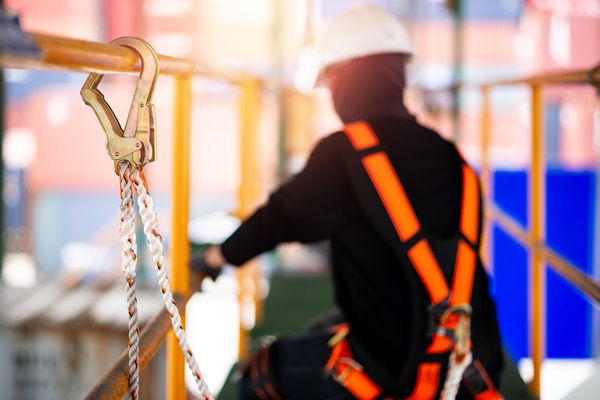
OSHA’s 2025 data shows more than 5,900 fall protection violations
Each year, the Occupational Safety and Health Administration (OSHA) tracks the nation’s most common workplace safety violations. And the same hazards continue to appear at the top.
For the 15th consecutive year, fall protection leads the list, proving how persistent and preventable many workplace dangers remain.
Falls are among the most serious threats facing American workers, especially in construction, manufacturing, and warehousing.
A missing guardrail, an unsecured ladder, or a lack of proper training can turn a routine task into a life-changing injury. Despite well-established safety standards, fall-related accidents continue to claim lives and cause severe injuries every year.
The most cited OSHA violations of 2025
Each year, OSHA releases its list of the most frequently cited safety standards. These violations paint a clear picture of where workplace safety efforts fall short. Many of the same issues appear year after year, signaling that progress in preventing injuries remains slow and inconsistent.
Below are OSHA’s Top 10 most frequently cited safety violations for fiscal year 2025, according to data shared at the National Safety Council’s Safety Congress & Expo:
- Fall Protection - General Requirements: 5,914 violations
- Hazard Communication: 2,546 violations
- Ladders: 2,405 violations
- Lockout/Tagout: 2,177 violations
- Respiratory Protection: 1,953 violations
- Fall Protection – Training Requirements: 1,907 violations
- Scaffolding: 1,905 violations
- Powered Industrial Trucks: 1,826 violations
- Personal Protective and Lifesaving Equipment – Eye and Face Protection: 1,665 violations
- Machine Guarding: 1,239 violations
This list serves as a warning to both employers and workers: the same types of hazards continue to injure and kill workers every year. In Ohio, where manufacturing, construction, and warehousing are central to the economy, these risks are particularly relevant. Employers are legally required to maintain safe workplaces, but when they cut corners or fail to provide adequate training, employees can pay the price.
Why fall protection keeps leading the list
Falling from heights is one of the deadliest types of workplace accidents, yet many of these incidents are easily preventable. OSHA’s standards require guardrails, safety harnesses, secure scaffolding, and consistent training for employees working at elevated levels. Despite these clear rules, thousands of employers continue to violate them.
Common reasons for fall protection violations include:
- Insufficient training: Workers are often sent onto roofs, scaffolds, or elevated platforms without proper instruction on how to use safety gear or identify risks.
- Missing or damaged equipment: Safety harnesses, guardrails, and anchor points are either not provided or not maintained.
- Unsafe ladders or scaffolds: Defective or improperly used climbing equipment remains a major cause of injury.
- Complacency or time pressure: Supervisors sometimes push deadlines over safety, putting workers in danger to finish jobs faster.
Every one of these failures can lead to catastrophic injuries such as broken bones, spinal trauma, or head injuries. When that happens, workers and their families may face months of lost wages, costly medical bills, and long recoveries. Having an experienced workers’ compensation lawyer can help injured employees secure the benefits they need to rebuild their lives.
The legal implications of OSHA violations
OSHA violations don’t just represent unsafe working conditions; they can also strengthen a worker’s claim for compensation. If an injury occurs due to a company’s repeated safety failures, the worker may be entitled to more than basic benefits. In some cases, a third-party injury claim can be filed if another contractor, equipment manufacturer, or property owner contributed to the accident.
An attorney familiar with workplace injury law can investigate the cause, identify safety violations, and ensure that evidence, such as safety reports, maintenance records, and witness statements, is preserved. These details often make the difference between a denied claim and full compensation for lost wages, medical care, and long-term disability.
Protecting injured workers in Ohio
Ohio law sets specific deadlines for filing workers’ compensation claims, and missing them can prevent an injured worker from recovering benefits. Acting quickly after a fall or other workplace accident gives victims the best chance to secure financial stability and medical support.
For more than 50 years, Hochman & Plunkett Co., L.P.A. has represented injured workers and their families across Dayton, Cincinnati, Springfield, Troy, Columbus, and throughout Ohio. Our Ohio work injury attorneys have more than 150 years of combined experience uncovering the truth behind serious workplace injuries and holding negligent employers accountable.
Sometimes you need an injury firm that digs deeper. If a job-related fall or safety violation caused serious harm, contact us for a free consultation today. Legal deadlines apply, so it’s important to act quickly to protect your rights and secure the benefits you deserve.
"Absolutely the best. They take care of everything. I would recommend them to everyone. They go above and beyond everyone else!" - Bob O., ⭐⭐⭐⭐⭐
